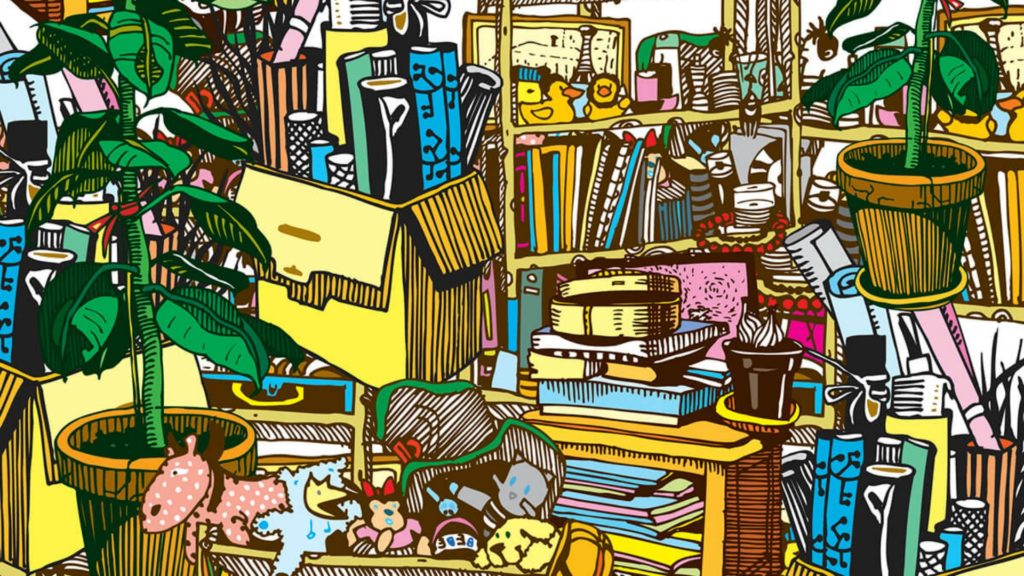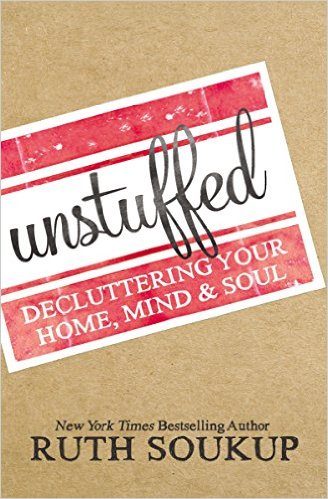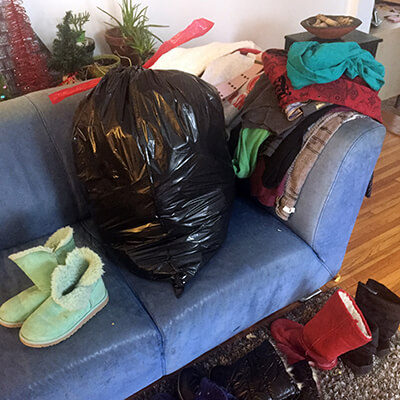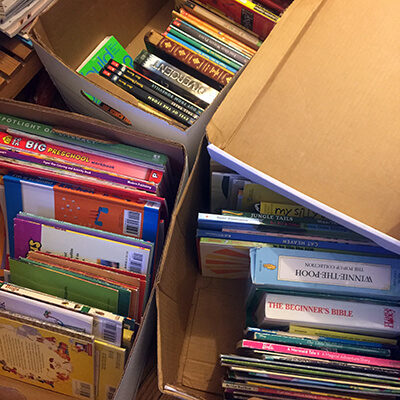
By Heidi Raschke – Living & Arts Editor
A week into My Great Decluttering Experiment, odd things begin to happen (for the uninitiated, I’m spending 30 days and trying four techniques; here is Part 1).
While listening to my first audiobook, The Life-Changing Magic of Tidying Up, I had been annoyed by decluttering guru’s Marie Kondo’s persistent references to “tidying your room.” I didn’t have a room; I had a house and a garage and a yard and a deck and a shed. Worse still, I had people who had filled all these beautiful spaces with their stuff in spite of my best efforts to keep everything under control.
After a hopeful start, my mood sank once again into blame and hopelessness, and my mind turned, funnily enough, to lawn care.
As I lightened my load, the mood around our household lightened, too. This was starting to be fun.
There, still in the box, stuck in a corner, was the hand-held weed trimmer I had bought in June. I had never used it because when I got the trimmer home, I realized the charging cord was not included and there was no time to go back to the store. Ironically, I had bought the tool to replace another perfectly good trimmer whose charging cord had been misplaced somewhere in our home for a good couple of years. That older trimmer was waiting out winter in the shed, banished to below-freezing temps with its weed whacker brethren for at least four more months. I would decide what to do with them in spring.
Planet Earth Is Blue, and There’s Nothing I Can Do
 In the meantime, I couldn’t avoid the fact that I was living in a weed-whacker wingding world of too much stuff and too many chores and family members who either couldn’t or wouldn’t take on the knives that needed sharpening, the jewelry that needed repair, the boxes of paperwork that needed sorting or shredding, the old electronics that need to be recycled and so on — no matter how much I begged, cajoled or hollered.
In the meantime, I couldn’t avoid the fact that I was living in a weed-whacker wingding world of too much stuff and too many chores and family members who either couldn’t or wouldn’t take on the knives that needed sharpening, the jewelry that needed repair, the boxes of paperwork that needed sorting or shredding, the old electronics that need to be recycled and so on — no matter how much I begged, cajoled or hollered.
I imagined battles over my younger daughter’s toys and collections. Her stack of Scholastic Book Club diaries alone was enough to put me over the edge. She didn’t want to get rid of anything. Ever.
I had been asking the teen to deal with the out-of-control clothes situation in her room for months to no avail.
Then there was the basement, which had become a sick-making symbol of the marital and financial crises our family had faced. Every attempt to clean it out was emotionally fraught.
Still, I had to start somewhere. But where? Kondo came with an answer: Tops. Really? My tops were hardly the problem. I wasn’t the one bringing in a steady stream of oversized sweaters from Goodwill (my teen) or insisting on keeping worn-out items for fabric (her little sister).
Commencing Decluttering Countdown, Engines On
Still, I gathered every shirt and sweater I own into a pile on the floor. Then I picked up each, kept those that “sparked joy” (in the words of Kondo) and discarded the rest, taking a few seconds to think about the purpose each had served in my life. The practice was remarkably clarifying.
Soon enough, I was talking to my clothes like a Kondo kook (not out loud!), expressing love for my favorite tops and breaking up with the rest. Said I:
- “It was such a thrill when I found you at that boutique in Seattle 15 years ago. I will always love you, but my life has changed and you’re just too scratchy and high-maintenance for me these days. It’s time to say goodbye.”
- “You’re really nice, I mean it, and that one time I wore you to lunch was enjoyable. But frankly, you’re not my style, and I don’t think this is going anywhere.”
- “What a great night that was when you fell into my lap, you crazy hand-me-down, you. But let’s be honest: We were both drunk, and this was a mistake.”
- “You look so great hanging there in the closet, so colorful, so beguiling. So why do you have to make me feel dumpy every … single … time I take you out. I can’t do this anymore. It’s over.”
- “Ugh, you again! Why are you still here? Get out!”
The reject bag filled quickly, and a new idea was taking root in my brain. Echoing in my head, it had a Seussian ring: “Then Heidi thought of something she hadn’t before! What if decluttering, she thought, doesn’t have to mean war. What if decluttering … perhaps … can be something more!”
Floating in a Most Peculiar Way

- Boots and clothes packed to go. On week two, even the teen was getting into the act.
Kondo had advised that you can’t declutter other people’s stuff. But I had resisted her admonition, thinking to myself: “Well, they’re not gonna do it. Look at this place. Certainly, Marie, you can’t compare your experience as a kid who threw away her family’s stuff without asking to me running a household. What I’m dealing with here is a whole ’nother kettle of fish. Actually, make that kettles. Lots and lots of kettles.”
While still in Kondo mode, I began the second audiobook in my self-imposed four-week decluttering boot camp hoping that Unstuffed: Decluttering Your Home, Mind and Soul by Ruth Soukup would have the answers for dealing with the real problem: my wonderful family.
Soukup was a declutterer I could relate to: a working mom with two daughters, a tendency to take on too much, a husband who resisted getting rid of stuff, a dog and a three-bedroom house. Her six-hour, 14-minute audiobook promised chapters on storage, kids, schedule, paperwork, other people’s stuff and more. Now we were talking.
On top of it all, her relationships were messy, her life was messy, her house was messy and her kids were messy. I listened to Soukup’s smart, practical tips, including limits on shopping, limiting closets to 40 hangers, limiting children’s toys to a certain amount of space, 10-minute daily cleanups and stashing children’s schoolwork into a bin daily, then reviewing and saving what’s special at year’s end. These ideas were great! She even laid out a road map for a weekend long purge that made decluttering sound like family fun.
As I continued to listen, I moved on from clothes to Kondo’s second category: Books. Again I found it easy to let go of old ones once I realized they had served their purpose in my life. As I lightened my load, the mood around our household lightened, too. This was starting to be fun.
Then one sunny, cold afternoon, a miracle occurred. As I puttered about, headphones in, my teen emerged from her room. “Mom, do we have any garbage bags?” she said. “Yeah, what for?” “I want to get rid of some clothes.”
Was this was the life-changing magic Kondo was talking about?
Feeling Very Still

- It turns out the decluttering bug is contagious. My kids helped me sort and pack up dozens of books for donation.
I handed the teen a bag and she disappeared back into her room. There was a some terrible clunking. A few hours later, the door opened. Out came a giant heavy-duty bag bursting with clothes she no longer needed. Then came a request to move beyond clothes to furniture and knick-knacks and posters. A few days later, she tackled her closet. I hadn’t said a word.
Kondo had said decluttering your own stuff would have ripple effects, but this display stunned me. I waited for Soukup to weigh in. Her advice came from a very different place, but it was exactly the same: Put on your own oxygen mask first. Once Soukup took a hard look at her own behavior, started decluttering her own closet, setting limits for herself and making fewer trips to Target, her family fell in line. Her husband was more willing to let go of stuff once he realized she wouldn’t just be bringing more in.
When my books were dealt with, my girls were happy to help me sort theirs. Our rule was: If a book sparks joy for anyone, that person gets to save it from going into the discard pile. In just a couple of hours, we gathered and sorted every picture book, chapter book and novel of interest to them. We created a special board-book shelf for a toddler friend who visits often and boxed up dozens of other books to give away.
That afternoon, our house was filled with the sweet contented sounds of children absorbed in reading. I didn’t have to worry about my kids spending too much time zoning out on a screen. They had more interesting things to do, and a less cluttered space to do it in.When my books were dealt with, my girls were happy to help me sort theirs. Our rule was: If a book sparks joy for anyone, that person gets to save it from going into the discard pile. In just a couple of hours, we gathered and sorted every picture book, chapter book and novel of interest to them. We created a special board-book shelf for a toddler friend who visits often and boxed up dozens of other books to give away.
A few days later, came another surprise: “Mom, when can we organize my dolls?”
I was two weeks and two books into My Great Decluttering Experiment and we were on a roll. We could do this!
The Second Book: Unstuffed
The book’s big idea: We have stuffed toyboxes, stuffed garages, stuffed closets, stuffed schedules, stuffed email inboxes, stuff coming at us constantly from all directions and a consumer culture that convinces us we need more stuff to be happy. That, Soukup says, is a big, fat lie. This is a guide to getting rid of the stuff that is weighing down not only your home but also your mind, body and soul.
Eye-roll factor: While Kondo seemed to be talking to single women with no kids living in small apartments, Soukup paints a pretty narrow picture of normal family life at times. But what bothered me most was her stereotypical descriptions of “we women,” with “our” tendencies to create friendship drama. Seriously?
Shrug factor: I suppose the word “soul” in the subtitle should have been a clue, but I didn’t realize this book had Christian bent until I was a few chapters in. And a little proselytizing goes a long way — we get it, your church and Bible studies are important to you.
Then again: In many ways, this book was an answer to my prayers. As I listened, I gained deep respect for Soukup, who reveals that she’s suffered child sexual abuse, divorce, a loss of faith, depression, suicide attempts and hospitalizations, illnesses, a flood, moves and the deaths of two close family members. She knows what it’s like to have troubles, and although her lens is a little narrow, she is empathetic to the struggles others face.
Big takeaways: This book reinforced what I learned from Kondo and enhanced it with dozens of nitty-gritty tips, tricks and tools for decluttering all aspects of your life. These are my faves:
- Say no to consumer culture
- Put on your own oxygen mask first
- Give others grace when they let you down; give yourself grace when you screw up, too
- Make decluttering your relationships a priority
- Make downtime and sleep a priority
- Focus on making your home warm and welcoming rather than picture-perfect
![]() This article originally appeared on Next Avenue
This article originally appeared on Next Avenue
© Twin Cities Public Television - 2017. All rights reserved.
Read Next



